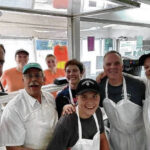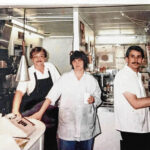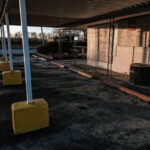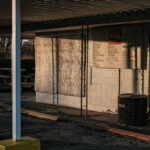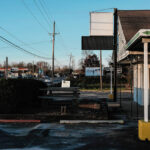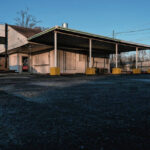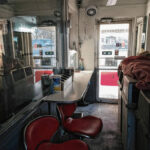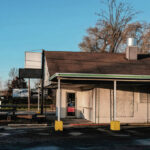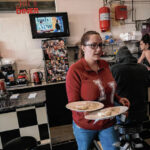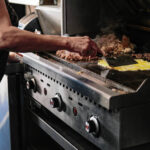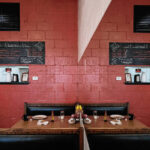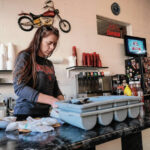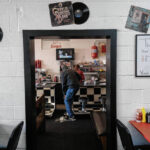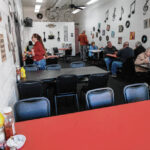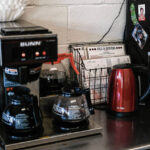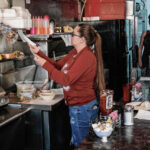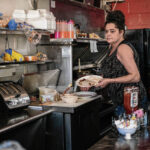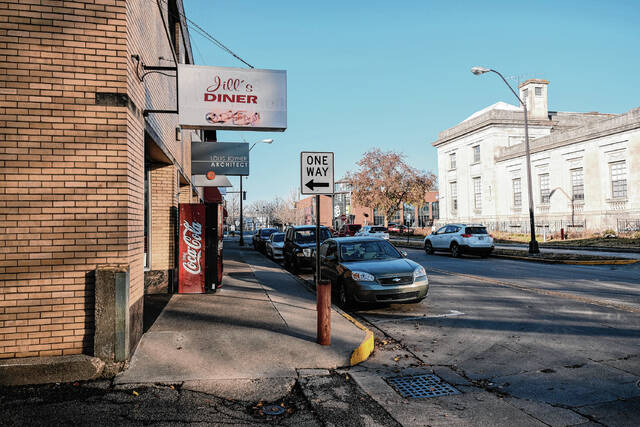
Mike Wolanin | The Republic A view of the sign outside Jill’s Downtown Diner in Columbus, Ind., Friday, Dec. 3, 2021.
Restaurants are continuing to respond to the challenges of serving customers amid a pandemic, but some owners have changed course, and others have decided to close their doors.
Musillami’s Drive-In shared on social media this fall that it was closing for the season, earlier than usual, due to issues with staffing and supplies. And on Nov. 28, the restaurant announced that it was closing permanently, though the restaurant is for sale.
“We regret to announce that we will not reopen,” the Musillami family wrote to customers. “For us this has been a bittersweet decision, but it is time to retire. We will miss all of you. No one had or has better friends and patrons. Thank you for 64 amazing seasons.”
The closure is more related to personal reasons than pandemic.
“I want to go out while I still enjoy the business,” said owner Mike Musillami, 69. “I love working with the people. We have a good crew. But it’s a little harder on me to physically go into work each day.”
His parents, Helen and Jasper Musillami leased the drive-in 1956 and bought it in 1957. The business was originally known as “Dairy Girl.” Florence Fritch ran the drive-in for a year with Helen’s help before asking if she would like to buy it.
In 2020, the Musillamis expected construction of the new overpass to slow down business for them, as State Route 11 would be closed. Then the pandemic hit.
However, since the restaurant was already in the takeout business, they were able to stay open.
“We became just extremely busy, and unfortunately, we had real long wait times,” Mike said. “People had to wait an hour or more sometimes just to get their food.”
“But they did it,” added his wife, Ruth, who kept books for the business.
“Yes, they did it,” he agreed. “And God love ‘em, they were happy to come on down.”
Both 2020 and 2021 were busy years for the drive-in, which doesn’t have inside dining. Mike predicted that dining in might become more “iffy” for businesses in the future, though it may remain popular at upscale restaurants.
While customers were in good supply, the drive-in did see some staff leave. Some employees — including their granddaughters — left for college. In other cases, a worker’s spouse would see a job change or relocation, which would result in a move for them as well.
“It was very, very hard to find people to work, but ours were more things outside their control,” Mike said. Still, he and his wife have fond memories of the different people — and families — who’ve worked at the drive-in.
According to Mike, several people have expressed interest in taking the business on.
For their part, the couple hope to enjoy their retirement and do some traveling.
“Obviously, we’re going to miss our employees,” Mike said. “We’re going to miss our customers. We’ve had salesmen that have been with us for over 20 years. Lots of delivery people who have been with us for long periods of time. And yes, we’re going to miss those people. And we’re hoping that we can stay in contact with them.
Reopening challenges
As one long-time restaurant decided to fold, another held a grand reopening after being closed for four months.
In late June, firefighters were called to Jill’s Downtown Diner due to a fire on the grill, which they believed to be caused, at least in part, by an accumulation of grease. Columbus Fire Department spokesman Capt. Mike Wilson said that damages were isolated to the grill area.
Reopening Nov. 13, Ashley Cundiff, daughter of owner Jill England, said that business has been “crazy” since reopening. Cundiff and her sisters help run the restaurant.
“We’ve been extremely busy, especially on the weekends,” she said. “If you come in here on the weekend during our rush hour, you’re looking at least a 45-minute wait on your food.”
Cundiff added that prior to closing, wait times were similar, but the “rush” didn’t last as long.
During the diner’s closure, the family did more than just repair damage from the fire. There were also a number of renovations and equipment replacements.
And while another restaurant might face staffing issues after being closed for four months, Cundiff said this has never been a problem for the business, which she described as “100% family-run.”
“We don’t really have, necessarily, a lot of room for a bunch of staff,” she said. “But I will say that in here, the customers are very quick to jump up and help with anything. I mean, if you come in here on the weekend, you’re guaranteed to either see a customer filling up the ice bin, a customer getting up and getting their own coffee, a customer helping roll silverware — the customers just jump in wherever they can, which is also a huge help.”
For Cundiff personally, the shutdown didn’t pose much hardship in terms of revenue. She had another job, as did one of her sisters. Another sister worked at different restaurant during the closure. Their mother, who was working seven days a week before the shutdown, took some time off.
Of course, the business is not without its challenges. Cundiff said the diner has faced some difficulty in determining the increases on its food costs. The family orders from a vendor based in Kentucky.
“Their costs are basically forecasted on every order, so just seeing those increases and trying to determine what our menu increases were going to be prior to knowing what the truck increases were going to be was a pretty big challenge,” she explained. “…We’ve always been known for our large portions and cheap prices, so we didn’t want to raise the prices a lot, so that was a challenge, but everything seems like it’s working out pretty well.”
She said it’s their first price increase and menu change since her mother bought the diner in 2008.
There are also challenges in availability, Cundiff said. A menu item will be ordered on the truck and not show up, so they’ll try local stores but still not be able to find it. She expects that other restaurants face the same problem.
Still, she has a positive outlook on the future. In addition to what Cundiff considers a good location, she believes there’s a “high demand for small, local businesses” at present. She also has faith in customer loyalty.
“My mother, Jill, has been a waitress her whole entire life,” she said. “And a good portion of our customers have followed her around to every place she’s worked. So I don’t see it going downhill. I do see it getting a little bit busier, if not staying steady.”
Downtown concerns
For another local business, 2021 brought expansion but also challenges.
In the fall, Lucabe Coffee Co. opened a second location in midtown Columbus. Co-founder and co-owner Tyler Hodge said the business has gone from a staff of 14 at one location to just over 35 at two.
According to Hodge, Lucabe is seeing growth from 2020 and also 2019 in some weeks — however, the new location has “far exceeded” the downtown spot in performance. The coffee shop has seen a reduction of about 40% from July to September downtown, and it’s been flat since.
Hodge said there are a few different contributing factors to the decline— including the return to school for students and the weather turning colder. He added that other “headwinds” are the continued closure of The Commons (except for rental events) and a lack of Cummins, Inc employees returning to offices downtown.
Hodge noted that from about 9:30 a.m. to noon, the business used to see a large crowd of young families stop by Lucabe, as well as The Commons and kidscommons. While some still do this, the number has decreased greatly over the past 18 months.
“It’s not just Cummins not being there that is causing the challenge; it’s also the lack of a second reason to come downtown,” Hodge said. “We’ve often heard, since the beginning of the business, ‘I just needed another reason to come downtown. You guys were the other reason.’ Now we’re one of the only reasons for that crowd in the middle of the day.”
He also said that other restaurant owners and managers are “concerned about the state of downtown” and what will happen over the next five or six months during the cold season.
For Lucabe, the new location is also a factor related to the downtown location which Hodge said has more convenient parking and a drive-thru.
“We’re essentially at a break-even level downtown,” he said. “And that can be sustained for a period of time but not indefinitely.”
He also said that there is “tremendous cost pressure” regarding materials. A $2 gallon of milk became $3. A $35-$40 case of cups is now $80. Costs have gone up 10% to 15% at a minimum, and 30% to 40% is more common. In “exceptional cases,” it’s 50% to 100%.
“I think restaurant owners are looking at that climate, coupled with the labor market, where the pressure on wages is ever-present, along with a cost structure that is exceeding their ability to price for it, along with in the case of downtown, a market that seems to be dwindling, at least in the cold months, and asking themselves the question, ‘Is it worth the effort?’” Hodge said. “Because owning a restaurant, owning a business is a tremendous amount of effort. You’ve got to have a passion for it.”
Inflation has a “spiral effect” on the local economy, Hodge said. When the business pays more for groceries, so do employees in their everyday lives, which leads to requests for higher wages. Higher wages mean higher prices for customers.
Margins in the restaurant business are already “super-thin,” he said. So shops have to drive up their prices or deal with the loss of staff members who find work with better pay.
Whatever the reason, the hospitality industry is seeing noticeable staffing issues across the country. The Bureau of Labor Statistics’ preliminary numbers from September of 2021 show about 1.38 million job openings in accommodation and food services. There were 1.06 million hires in that month, but also “quit levels” of 863,000, as well as 1.03 million separations. With 6.4% of employees quitting, hospitality had a higher rate than any other industry in September. In contrast, the total quit rate across all industries was 3%.
In looking at the future, Hodge expressed optimism about both Columbus and Lucabe. And in spite of his concerns, he added that he’s also positive about downtown and its “tremendous charm and opportunity to be a differentiator.”
“We like to be part of that environment downtown,” he said. “We enjoy it, want to stay. We’re just hopeful that some of those other factors that have been a challenge for us over the past year and a half turn around sooner than later — a larger workforce population, more amenities and attractions for people to have multiple reasons to come downtown. … We’re excited about the future, but we’re still in adaptive mode, reacting to a lot of the challenges in front of us.”
A photo of the last day of operations in 2021, shown in front are Rob Musillami, Mike Musillami, Tessa Mayer, Jackson Mayer, JP Mayer, and Duke Lee, and in the back, Ruth Anne Mayer and Sophia Musillami.
Photo provided A Musillami’s photo from 1986, showing Al Gerken, Vic Richardson and Mike Musillami.
Photo provided Mike Musillami, center, is shown with his grandchildren, top row, Sophia Musillami and Ruth Anne Mayer and bottom row, Jackson Mayer and Adrianna Musillami.
Mike Wolanin | The Republic An exterior view of Musillami’s Drive-In on Jonesville Road in Columbus, Ind., Tuesday, Nov. 30, 2021. The owners of the restaurant recently announced that they will not reopen in the spring and that the restaurant is for sale.
Mike Wolanin | The Republic Tyler Hodge, co-owner of Lucabe Coffe Co., talks about how his business has been impacted by COVID-19 in Columbus, Ind., Monday, March 16, 2020.
Mike Wolanin | The Republic An exterior view of Musillami’s Drive-In on Jonesville Road in Columbus, Ind., Tuesday, Nov. 30, 2021. The owners of the restaurant recently announced that they will not reopen in the spring and that the restaurant is for sale.
Mike Wolanin | The Republic An exterior view of Musillami’s Drive-In on Jonesville Road in Columbus, Ind., Tuesday, Nov. 30, 2021. The owners of the restaurant recently announced that they will not reopen in the spring and that the restaurant is for sale.
Mike Wolanin | The Republic An view of a menu board on the side of Musillami’s Drive-In on Jonesville Road in Columbus, Ind., Tuesday, Nov. 30, 2021. The owners of the restaurant recently announced that they will not reopen in the spring and that the restaurant is for sale.
Mike Wolanin | The Republic An exterior view of Musillami’s Drive-In on Jonesville Road in Columbus, Ind., Tuesday, Nov. 30, 2021. The owners of the restaurant recently announced that they will not reopen in the spring and that the restaurant is for sale.
Mike Wolanin | The Republic An exterior view of Musillami’s Drive-In on Jonesville Road in Columbus, Ind., Tuesday, Nov. 30, 2021. The owners of the restaurant recently announced that they will not reopen in the spring and that the restaurant is for sale.
Mike Wolanin | The Republic An exterior view of Musillami’s Drive-In on Jonesville Road in Columbus, Ind., Tuesday, Nov. 30, 2021. The owners of the restaurant recently announced that they will not reopen in the spring and that the restaurant is for sale.
Mike Wolanin | The Republic An exterior view of Musillami’s Drive-In on Jonesville Road in Columbus, Ind., Tuesday, Nov. 30, 2021. The owners of the restaurant recently announced that they will not reopen in the spring and that the restaurant is for sale.
Mike Wolanin | The Republic An interior view of Musillami’s Drive-In on Jonesville Road in Columbus, Ind., Tuesday, Nov. 30, 2021. The owners of the restaurant recently announced that they will not reopen in the spring and that the restaurant is for sale.
Mike Wolanin | The Republic An exterior view of Musillami’s Drive-In on Jonesville Road in Columbus, Ind., Tuesday, Nov. 30, 2021. The owners of the restaurant recently announced that they will not reopen in the spring and that the restaurant is for sale.
Mike Wolanin | The Republic Patrons gather at Jill’s Downtown Diner in Columbus, Ind., Friday, Dec. 3, 2021.
Mike Wolanin | The Republic Lindsey Cundiff carries orders of biscuits and gravy to a table at Jill’s Downtown Diner in Columbus, Ind., Friday, Dec. 3, 2021.
Mike Wolanin | The Republic Jill England cooks an omelette at Jill’s Downtown Diner in Columbus, Ind., Friday, Dec. 3, 2021.
Mike Wolanin | The Republic An interior view of Jill’s Downtown Diner in Columbus, Ind., Friday, Dec. 3, 2021.
Mike Wolanin | The Republic Ashley Cundiff rolls silverware at Jill’s Downtown Diner in Columbus, Ind., Friday, Dec. 3, 2021.
Mike Wolanin | The Republic An interior view of Jill’s Downtown Diner in Columbus, Ind., Friday, Dec. 3, 2021.
Mike Wolanin | The Republic Patrons eat at Jill’s Downtown Diner in Columbus, Ind., Friday, Dec. 3, 2021.
Mike Wolanin | The Republic Menus sit in a basket next to the coffee machine at Jill’s Downtown Diner in Columbus, Ind., Friday, Dec. 3, 2021.
Mike Wolanin | The Republic Lindsey Cundiff puts in food orders at Jill’s Downtown Diner in Columbus, Ind., Friday, Dec. 3, 2021.
Mike Wolanin | The Republic Jill England serves up a plate of breakfast food at Jill’s Downtown Diner in Columbus, Ind., Friday, Dec. 3, 2021.
Mike Wolanin | The Republic A television shows local news at Jill’s Downtown Diner in Columbus, Ind., Friday, Dec. 3, 2021.
Mike Wolanin | The Republic Ashley Cundiff, right, rings up Tom Vickers at Jill’s Downtown Diner in Columbus, Ind., Friday, Dec. 3, 2021.
Mike Wolanin | The Republic A view of the sign outside Jill’s Downtown Diner in Columbus, Ind., Friday, Dec. 3, 2021.

